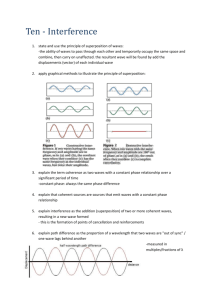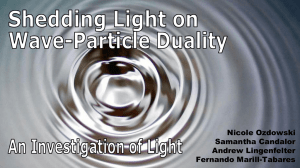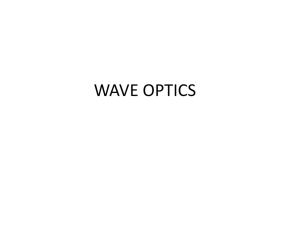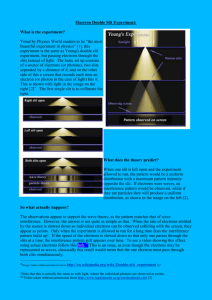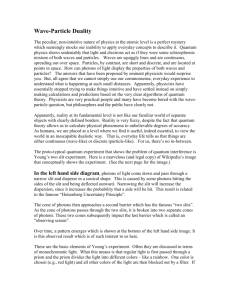LabanyaMukhopadhyay_COSMOSCluster2_FinalProject
advertisement
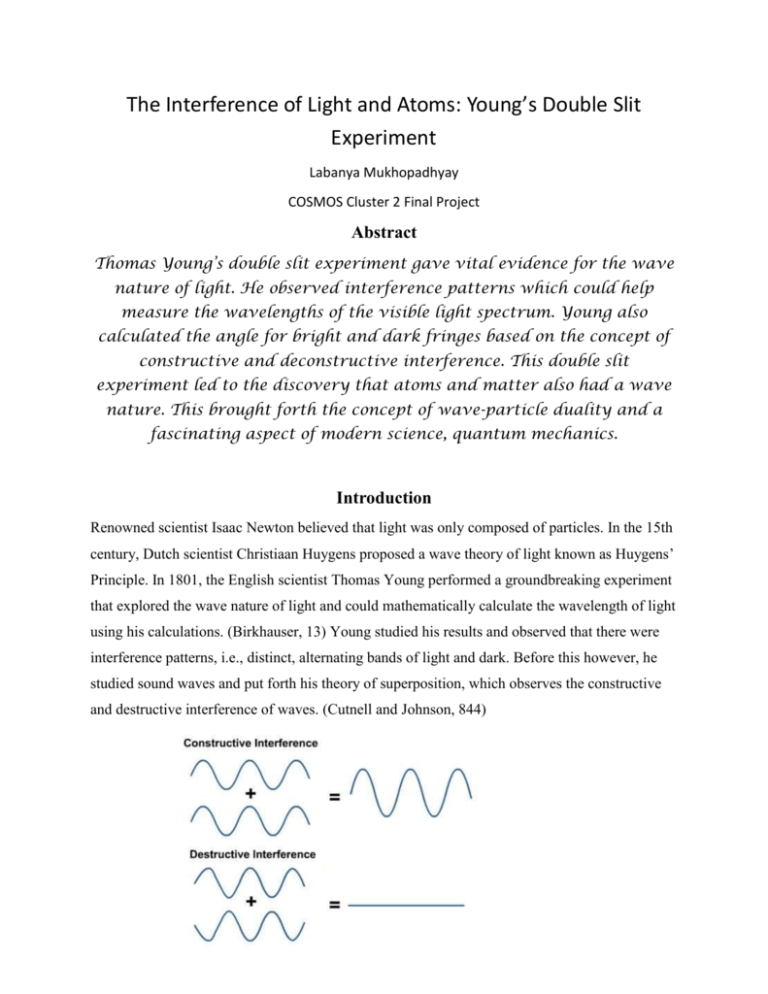
The Interference of Light and Atoms: Young’s Double Slit Experiment Labanya Mukhopadhyay COSMOS Cluster 2 Final Project Abstract Thomas Young’s double slit experiment gave vital evidence for the wave nature of light. He observed interference patterns which could help measure the wavelengths of the visible light spectrum. Young also calculated the angle for bright and dark fringes based on the concept of constructive and deconstructive interference. This double slit experiment led to the discovery that atoms and matter also had a wave nature. This brought forth the concept of wave-particle duality and a fascinating aspect of modern science, quantum mechanics. Introduction Renowned scientist Isaac Newton believed that light was only composed of particles. In the 15th century, Dutch scientist Christiaan Huygens proposed a wave theory of light known as Huygens’ Principle. In 1801, the English scientist Thomas Young performed a groundbreaking experiment that explored the wave nature of light and could mathematically calculate the wavelength of light using his calculations. (Birkhauser, 13) Young studied his results and observed that there were interference patterns, i.e., distinct, alternating bands of light and dark. Before this however, he studied sound waves and put forth his theory of superposition, which observes the constructive and destructive interference of waves. (Cutnell and Johnson, 844) When waves are in phase, meaning their crests and troughs match up, they have constructive interference and the amplitude doubles. However, when the crests do not match the other wave’s crests, destructive interference occurs and some or all of the amplitude is cancelled out. This image shows another way of understanding constructive interference. The two waves are at an angle to each other and meet at both of their crests. This shows destructive interference where the two waves are at an angle to each other. With this concept, Thomas Young performed his double slit experiment and noticed bright and dark bands of light due to interference patters, thus proving light was a wave and not always a particle as the corpuscular theory suggested. He published his findings in his paper “On the Nature of Light and Colors”. (Achinstein, 19) Methods "The experiments I am about to relate ... may be repeated with great ease, whenever the sun shines, and without any other apparatus than is at hand to everyone." stated Thomas Young in his speech to the Royal Society of London in 1803. Unlike the image, Young used sunlight as his source of light since non-natural light was not yet invented. In a darkened room, he directed the beam of sunlight though a hole in his window shutter and a plate of glass and placed “a slip of card, about one thirtieth of an inch in breadth” to split the beam into two slits. To observe his results, he placed a screen at a distance from the slit. Young did not see only two slits as the widely believed corpuscular theory suggested. He saw distinct bands with the most brightness at the center band and least at the ends. This meant that there was interference which shows that light behaves as a wave. To make this more apparent, Young used water waves to model how the light waves interact. Results After conducting the double slit experiment using light, he saw a series of alternating dark and light bands due to interference patters, which showed that light was a wave. He explained this phenomenon using a ripple tank. When the single wave of water entered the two slits, it formed two different waves through each slit. They combined to form a crossing pattern and struck the screen. This is also what happens with light waves. When the one light beam enters the two slits, two waves are created with combine like the ripples. An interference pattern forms the bright and dark bands on the screen. When the two waves interfere, the bright bands appear where the crests of the two waves meet, or contructive interference. The dark fringes appear due to destructive interference, where the crests and troughs meet, and therefore the two waves cancel each other out and there is no light in that area. The distance from both slits to the center band is equal which makes it the brightest band. Discussion Young could find the band gap of the interference pattern using the equation 𝒚 = 𝒎𝝀𝑫 𝒅 where y is the band gap, D is the distance from the slit to the screen, d is the distance between the two slits. In the image, 𝛿 represents the difference from slit 1 to the screen and slit 2 to the screen. Proof: Since both distances have the same wavelength, 𝛿 can be written as 𝑚𝜆 where m is any integer (the difference can only be an integer because there can be constructive interference when the difference is a multiple of the wavelength). We can assume that 𝜃 = 𝜃 ′ since both are very small angles. sin 𝜃 ′ = So, 𝛿 𝑑 = 𝑚𝜆 𝑑 𝑚𝜆 = tan 𝜃 = 𝑑 𝑦 𝐷 and 𝒚 = 𝒎𝝀𝑫 𝒅 𝑦 𝐷 He also could find the angle 𝜃 for both constructive and destructive interference patterns. 𝜆 where m is 0, 1, 2, 3… For the bright fringes: sin 𝜃 = m For the dark fringes: 1 𝜆 sin 𝜃 = (m + ) where m is 0, 1, 2, 3… 2 𝑑 𝑑 1 The dark fringe equation has (m + ) because there will be destructive interference when the two 2 waves are exactly out of phase and there is a wavelength difference of 1 . 2 Young's Double-Slit Experiment with Atoms: The double slit experiment also had another application: to show the wave nature of atoms. By experiments performed in 1961 by Claus Jönsson at the University of Tübingen in Germany, scientists already knew that a beam of atoms diffracted with each other to form an interference pattern. (Johnston, physicsworld) Could a single electron behave like a wave also? Giulio Pozzi and colleagues at the University of Bologna did the first single-electron double-slit in 1974. They passed electrons one at a time through a bi-prism, which is an electron optical device that acts as a double slit, and saw a diffraction pattern. In 2008, the same group repeated the experiment but used an actual double slit, the first ones to do so. (Johnston, physicsworld) Electrons were fired one by one at a double slit, where they were not expected to show any interference since there were no other particles to interact with. On the other hand, over time the electrons formed an interference pattern composed of alternationg bands. This showed that somehow the electron could interfere with itself. To figure out which slit the electron passed through, scientists placed an observer or particle detector. With the observer, the electrons returned to its particle nature and showed no interference. This meant that electrons could act as a wave and a particle, thus leading to the wave-particle duality. In 1923, the French Louis de Broglie proposed that matter behaves like a wave and displays wave-particle duality of photons. (Cutnell and Johnson, 912) The de Brogie wavelength is the wavelength that is related to an object’s momentum. This can be derived by a series of well known equations. (E is energy, m is mass, c is speed of light, 𝑣1 is frequency, h is Planck’s constant, and v is velocity). E = 𝑚𝑐 2 E = h 𝑣1 Both energies are equal so 𝑚𝑐 2 = h 𝑣1 The object does not necessarily move at the speed of light so c will be replaced by v: 𝑚𝑣 2 = h 𝑣1 𝑣 𝑣 𝜆 𝜆 By equation 𝑣1 = , 𝑚𝑣 2 = h 𝜆=ℎ 𝑣 𝑚𝑣2 = ℎ 𝑚𝑣 mv is momentum. Therefore, 𝝀= 𝒉 𝒑 My Approach to the Double Slit Experiment: Two years ago I performed the double slit experiment using a homemade set up and some altercations to Young’s original experiment. For example instead of sunlight as the light source, I used a laser pointer which emits light coherently. I constructed my slits by carefully perforating cardstock and placing a thin wire through the opening to create two slits. I mounted the slits and the laser at an equal height and placed a screen 60 to 115 inches away from the slits. I noticed that the laser beam had to be larger than the slits or there would not be any interference. Also the distance from the slits to the screen must be considerable large (as can be seen from the equation 𝒚 = 𝒎𝝀𝑫 𝒅 where D had to be very large or else 𝜃 = 𝜃 ′ would not be true. This is the interference pattern of the double slit with the red laser. I could measure the band gap y, the distance between each band, and the distance from the slit to the projector D, the distance between the two slits d, the specific band from center m, and the wavelength of the red LED which is 25.6 X 10-6 inches. D (inches) (10-3 inches) 60 55 140 65 60 120 70 69 75 80 80 83 85 83 90 97 95 111 100 104 105 111 110 111 115 132 ( 10_3 Inches) Bright Fringe Gap Band Gap for Red Laser 100 80 60 Blue Laser 40 Red Laser 20 Green Laser 60 65 70 75 80 85 90 95 100 105 110 115 0 Distance D (Inches) This is the band gap that I measured on the screen. 120 Calculated Bright band gap 100 80 60 Blue Laser 40 Red Laser 20 Green Laser 60 65 70 75 80 85 90 95 100 105 110 115 0 Distance D (Inches) This is the band gap I calculated with the known equation 𝑦= 𝑚𝜆𝐷 𝑑 Band Gap . The results I measured from my experiment were fairly close to the results found by Young’s equation. Young’s double slit experiment is a D Band Gap (inches) (10-3 inches) 60 51.2 65 55.5 70 59.7 75 64 80 68.3 85 72.5 90 76.8 95 81.1 100 85.3 105 89.6 110 93.9 115 98.1 simple yet profound approach to some of the most fascinating concepts in physics: wave interference and wave-particle duality. References: Achinstein, Peter. Particles and Waves: Historical Essays in the Philosophy of Science. New York: Oxford UP, 1991. Print. Carnal O., and J. Mlynek. “Young’s Double Slit Experiment with Atoms: A Simple Atom Interferometer.” Physical Review Letters. APS Physics, 27 May 1991. Web. 27 July 2015. Cutnell, John D., and K. Johnson. Physics. Vol. Two. Hoboken, NJ: John Wiley, 2009. Print. Giancoli, Douglas C. Physics: Principles with Applications. Upper Saddle River, NJ: Prentice Hall, 1998. 723-30. Print. Nahum Kipnis, History of the Principle of Interference of Light. Birkhauser Verlage, Basel, 1991. Print. Shneider, Walter. "Do the "Double Slit" Experiment the Way It Was Originally Done." Cavendishscience.org. The Physics Teacher 24 217-219, 1986, n.d. Web. 26 July 2015. Thomas Young, Experimental Demontration of the General Law of the Interference of Light, “Philosophical Transactions of the Royal Society of London”, vol 94 (1804) Print. "Young's Double Slit Experiment." OpenStax CNX. Rice University, n.d. Web. 30 July 2015.


